Toilets
Toilet Tank Not Filling
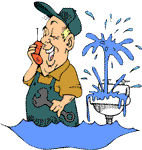 A toilet tank not filling correctly can cause problems with how the toilet flushes. Toilets need a certain amount of water to work properly, too little water and the toilet will clog or flush slowly.
A toilet tank not filling correctly can cause problems with how the toilet flushes. Toilets need a certain amount of water to work properly, too little water and the toilet will clog or flush slowly.
It may make economic sense to lower the water level in the tank, to save money. However, it does not make good toilet flushing sense.
Too little water in the tank can cause the flush slowly or not at all. This will cause the toilet to clog and create and unpleasant situation. Toilets are engineered to work with a certain amount of water. Make sure that when the tank fills it is near the top of the tube for the flush valve.
See the article 'How to Fix a Toilet' if this is not your problem, it covers all of the toilet repair topics.
Toilets are designed to use a certain amount of water to flush. With the water consumption limitations imposed by the government, all of that water is needed for the toilet to work properly. Reducing the level in the tank will cause the toilet to flush poorly. A 'slow flushing toilet' is a sign of too low a water level.
What Is the Proper Toilet Tank Water Level?
With the lid taken off you should be able to see a round vertical tube in the center of the tank. It will have the toilet flapper and a fill tube attached to it. The vertical tube is part of the toiltet flush valve.
The proper water level for most tanks is near the top of that vertical tube. Some tanks will have a line and an indication that is is the 'fill line'. If you have markings inside your tank, you want make sure the water is set to that level.
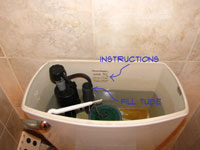 For tanks with no markings, you will set the water level just below the top of the fill tube. Stay about 1/2" down from the top. You do not want to get too close to the top, otherwise it will run over and trickle into the tank.
For tanks with no markings, you will set the water level just below the top of the fill tube. Stay about 1/2" down from the top. You do not want to get too close to the top, otherwise it will run over and trickle into the tank.
Adjusting a Toilet Fill Valve
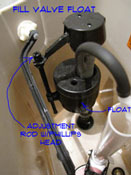 When you look into the toilet tank you will see off to one side another vertical elment the has a built in float on it. It will also have a tube that is connects it to the fill tube in the center. The bottom of this assembly is connected to the water supply line for the toilet.
When you look into the toilet tank you will see off to one side another vertical elment the has a built in float on it. It will also have a tube that is connects it to the fill tube in the center. The bottom of this assembly is connected to the water supply line for the toilet.
This is the fill valve. The fill valve has a float on it that can be adjusted to set the water level in the tank. Most fill valves have a float that slides up and down on the vertical fill valve. There is a retaining clip or a screw device that allows for adjustment.
When the water is too low in the tank, you want to raise it. Simple, right? Yes it is, fortunately, the float adjusts the same way the water needs to go. To raise the water level, raise the float. To lower the water, lower the float.
A fluidmaster vertical fill valve will have an adjustment shaft with a phillips screw inset at the top. Turn the shaft clockwise to raise and counterclockwise to lower. Older ones will have a metal shaft with a spring clip on it. Pinch the spring clip and raise or lower the float as desired.
Adjusting a Toilet Ball Float
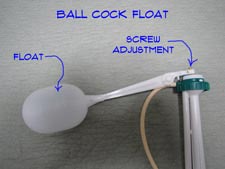 Some toilets will have a ball cock that acts as a float. This will be connected to a horizontal rod that is connected to the fill valve. There will be a adjustment screw where the rod connects to the fill valve.
Some toilets will have a ball cock that acts as a float. This will be connected to a horizontal rod that is connected to the fill valve. There will be a adjustment screw where the rod connects to the fill valve.
To raise the water level you want to raise the float. Adjust the set screw or the clip on the float.The direction to turn the screw will depend on the design of the float valve. You may have to experiment a little to determine whether you are raising or lowering the float. The same rules apply with floats, raise it to raise the water level and lower it to lower the water level.
Checking the Toilet Tank Water Level
Before you pat yourself on the back for a job well done, you want to do a couple of test runs. Flush the toilet and let it fill back up.
It should stop filling at the mark on the tank or just below the top of the fill tube (approximately 1/2" below the top). If it fills too high it will start trickling into the fill tube and down into the toilet, wasting water. Make corrections as needed.
Check the water level on your tank periodically to make sure that it continues to fill properly. This will help to avoid toilet clogs and noisy water wasting situations.
Slow Flushing Toilet
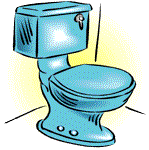 What can you do about a slow flushing toilet? This problem is common in older toilets. Addressing issues with the water quantity and flow will help this issue.
What can you do about a slow flushing toilet? This problem is common in older toilets. Addressing issues with the water quantity and flow will help this issue.
Not sure if this your problem? See the article 'How to Fix a Toilet' for a complete listing of all of the toilet repair topics.
There are (3) Key Topics associated with a 'Slow Flushing Toilet': (1) 'Adjusting the Toilet Tank Water Level' covers a low water supply in the toilet tank. (2) Older toilets and houses with hard water can get a sediment build up in the water inlet. 'Cleaning Out Toilet Sediment' covers this issue. (3) 'Removing Toilet Blockages' talks about partially blocked toilets that will flush slowly.
Toilets are engineered to use a certain amount of water to flush. When the water rushes into the bowl, it creates a siphon that removes the waste and rinses the bowl. Too little water or water that gets there too slow can cause the toilet to flush poorly.
Water Usage for Toilets
Toilets that used a large supply of water would be prone to slow flushes. Hard water and sediment can also be a factor.
A toilet that flushes slowly can be very annoying. When a toilet does not flush properly, clogs are frequent. A clogged toilet is more than irritating. The dirty messy water is no fun and can be a health hazard.
In the mid nineties, toilets had to start using 1.6 gallons of water per flush. Prior to that time toilets could use 3.5 to as high as 7 gallons of water. The design of toilet would require that the full amount be used. In an effort to conserve, some homeowners would adjust the water level down. This will cause the toilet to flush slowly, since there is not enough water pressure to create the proper siphon effect.
Issues With a Slow Flushing Toilet
What Can You Save? - A plumber can usually take care of this problem in a single service call. Normally this will run from $75 to $100. One danger is that the toilet will be condemned and the plumber will try to sell you a new toilet.
How Hard Could It Be? - Fixing the common causes of a slow flushing toilet is not difficult. | These repairs will have a Difficulty Level of: Simple | These repairs require a Skill Level of: Job Jar Specialist | For and explanation of the terms in this section, see 'How to Use This Site'.
Check the Simple Things! - Adjusting the float to set the water level to the correct height is the easiest fix. Most toilets are designed to work properly with the water level at the maximum level in the tank.
What Can Go Wrong? - Not fixing a slow flushing toilet can lead to toilet clogs. A clogged toilet can be very disruptive. Not to mention the mess that can be made by the dirty water. Another issue is that the toilet may need to be flushed multiple times, wasting water.
Troubleshooting a Slow Flushing Toilet
The amount of water in the toilet tank is critical to proper flushing. The article 'Adjusting the Toilet Tank Water Level' provides instructions on adjusting it to the proper level.
Another common problem is a build up of sediment in the inlets for the bowl. If the water does not get into the tank quickly enough, it won't flush properly. See 'Cleaning Out Toilet Sediment' for a review.
'Removing Toilet Obstructions' discusses how a clog or partial clog can affect the operation of your toilet. Removing them is the only choice.
Summary
Were you able to deal with your slow flushing toilet? It may have been as simple as adjusting the float. This is especially true for older toilets. In years gone by, toilets needed a lot of water to flush properly. When the tank level gets too low, the proper siphoning will not start.
Another common problem is sediment in the inlet valve. Again, older toilets are more likely to have this trouble. Then there is the 'object' stuck in the trap. No one knows how is got there, but it sure has caused a problem. Dislodging objects is not too hard and hopefully, you are up and running again.
How To Snake a Toilet
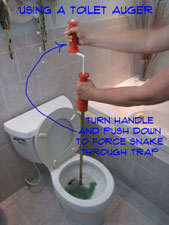
 A toilet auger is a useful tool when you have a clogged toilet. You may want to try 'Using a Toilet Plunger' before you attempt to use an auger, it is a little easier.
A toilet auger is a useful tool when you have a clogged toilet. You may want to try 'Using a Toilet Plunger' before you attempt to use an auger, it is a little easier.
Not sure what your problem is? See the article 'How to Fix a Toilet' to troubleshoot your problem.
When you hear those fateful words, 'the toilet is clogged again', it gives you less than good feeling. You try and brace yourself for a dirty situation. What do you do?
There are two tools that can take care of a clogged toilet efficiently. One is a toilet auger. With one of these you can get rid of most clogs in five minutes or less. The other commonly used tool is a plunger. The auger will generally be needed for tougher clogs, although it can be used any time the toilet refuses to flush.
This article will help you with the when and how of using this tool. You don't need to dread it when the toilet clogs up. Instead, you can be the hero that is able to fix it quickly and efficiently. This article will give you the information you need.
Using a Toilet Auger - Information
What Can You Save?
A service call for a plumber will likely be around $75. You will be dismayed when he unclogs your toilet in less than five minutes with a tool that costs around $20.
How Hard Could It Be?
Using a toilet auger is not hard or complicated. It can be a little messy.
- Difficulty Level of: Easy
- Skill Level of: Handyman
Check the Simple Things!
Using a plunger is about the simplest thing for a toilet clog. Plungers will work most of the time, although it may take repeated tries.
What Can Go Wrong?
Dirty water is the big problem with working on a toilet. You can't tell that the toilet is clogged until you flush it. Many times, the mistake of flushing it a second time is made. This means a bowl full of very dirty water. Clear out the area before you work on the toilet. Have some rags handy to quickly deal with any mess.
Purchasing a Toilet Auger
A toilet auger is a manual snake that is just long enough to get through the piping in your toilet. It will dislodge objects that are caught in the trap. You can buy a toilet auger for twenty five or thirty dollars and it will last for years.
Purchasing a toilet auger is not too difficult. Big box home supply stores have them in stock.
This tool is less common than a plunger. It is essentially a snake that is designed to go through the trap on a toilet. It has a long handle with a twist crank at the top. This allows you to turn the auger while pushing it down through the trap.
Home supply stores have toilet augers for sale. One will cost between $15 and $75. The more expensive ones will have a heavier snake that will not kink as easy. This tool is somewhat distinctive, in that it looks a lot like a 'J' and stands about three feet high.
Using a Manual Toilet Snake
Toilets have a trap in them that create some sharp bends in the pipe. This is where the clogs generally occur. The metal snake in the toilet auger is just long enough to get through the trap and to the base of the toilet.
Pull the handle all the way up and position the auger in the trap opening Push down while turning the handle. When the handle gets to the bottom it is all the way through the toilet. Similar to the plunger you may need to try a few times. When it gets caught try to force it through, this is probably the culprit. Don't hurt yourself, but use a little elbow grease.
The toilet auger does do a dirty job so cleaning it off is a concern. Once the toilet is unplugged you can flush it a time or two with the snake still inside the toilet. The water will help rinse off the snake. The remainder of cleaning can be done outside with a garden hose.
Using a toilet auger is not too difficult, but it does require some arm strength. The crank has to be turned manually and pushed through the trap.
Remove everything from the area that could be damaged by dirty water. Some water will probably splash, move anything you don't want ruined. Have a mop and rags nearby, just in case.
If the water level is up near the rim, you may need to get a small pail and bail some of the water out. A plunger will displace water when it is used. In addition plunging will agitate the water. A high water level will cause splashing and spillover.
Again the toilet auger is a manual snake that is just long enough to get through the piping in your toilet. It will dislodge objects that are caught in the trap. It is not electric and therefore requires some arm strength to operate it. The idea is to turn it and force it through the trap at the same time.
Pull the handle all the way up and position the auger in the trap opening. The bottom of the auger is turned to help get it started. Make sure the end of the metal snake is turned toward the back of the toilet. Push down while turning the handle. When the handle gets to the bottom it is all the way through the toilet.
Some toilet clogs may resist your efforts. It may require more than one try to free up the clog. Don't despair, pull the handle back and try it again. It may feel like you have hit a wall and can't get the snake to go through. When it gets caught try to force it through, this is probably the culprit or the top of the trap. Don't hurt yourself, but use a little elbow grease. You need to get the snake all the way through the toilet, or extended the full length to make sure the clog is gone.
A toilet auger is a manual snake that is just long enough to get through the piping in your toilet. It will dislodge objects that are caught in the trap. You can buy a toilet auger for twenty five or thirty dollars and it will last for years.
Toilets have a trap in them that create some sharp bends in the pipe. This is where the clogs generally occur. The metal snake in the toilet auger is just long enough to get through the trap and to the base of the toilet.
Pull the handle all the way up and position the auger in the trap opening Push down while turning the handle. When the handle gets to the bottom it is all the way through the toilet. Similar to the plunger you may need to try a few times. When it gets caught try to force it through, this is probably the culprit. Don't hurt yourself, but use a little elbow grease.
Unclogging a toilet with an auger is done when there is something caught in the trap. A toilet auger is a little harder to use than a plunger and most homeowners do not have one.
A toilet auger is a manual snake that is just long enough to get through the piping in your toilet. It will dislodge objects that are caught in the trap. It has a hand crank on it to turn the snake. This tool is especially useful for dislodging obstructions that are caught in the trap, such as a toothbrush or a children's toy.
To use the toilet auger make sure that the snake is in the retracted position. Place the end of the auger in the bottom of the toilet basin, witht the snake pointed toward the back of the toilet. Hold the auger steady with one hand.
Push down while turning the handle.You will likely get some resistance when the auger hits the obstruction and when it tries to make the turn in the trap. This is normal, keep turning the auger until it works its way through.
When the handle gets to the bottom it is all the way through the toilet. Similar to the plunger you may need to try a few times.
Summary
You may want to do some maintenance on your toilet at this time. See the articles 'Adjusting Toilet Tank Water Levels' and 'Checking the Toilet Flapper' for more information.
How To Unclog a Toilet With a Plunger
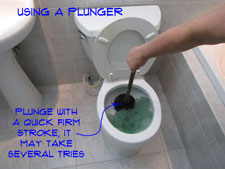 Without a doubt a 'Plunger' can solve clogged toilet problems most of the time. The best part is that you can save the cost of a plumber coming at maybe a hundrfed bucks or more in less than five minutes.
Without a doubt a 'Plunger' can solve clogged toilet problems most of the time. The best part is that you can save the cost of a plumber coming at maybe a hundrfed bucks or more in less than five minutes.
There are two tools that can take care of a clogged toilet efficiently. One is a toilet plunger. We mentioned this at the outset, most of the time, ( I mean in the high 90% range, this is the right tool), to deal with a clogged toilet. For a really tough obstruction that is caught in the trap, a toilet auger is the second choice.
How Does a Toilet Plunger Work
Plungers work on a simple concept, pressure. The plunger generates pressure on the clog to force it through the trap. This is usually successful, since it is too much volume that clogs toilets in most instances.
This can be very effective, since it is too much volume that clogs toilets in most instances.
Purchasing a Plunger
A toilet plunger is a very simple device. It is a long handle connected to a rubber bulb. The rubber end is designed to compress. When properly seated in the toilet, quickly compressing the plunger generates pressure that forces the clog through the toilet.
You will also find some newer styles that look almost like an accordion. These are designed to generate even more pressure.
Toilet plungers are readily available at home supply and hardware stores. Even department stores will have them for sale. A plunger for a toilet will have an added flange at the bottom that helps to concentrate the pressure. This differs from a sink plunger that has no added flange. Look for one with a bell that is about six inches and diameter and five inches high. One will cost between $5 and $15.
Plunging a Toilet
Remove everything from the area that could be damaged by dirty water. Some water will probably splash, move anything you don't want ruined. Have a mop and rags nearby, just in case.
For the plunger to do its job, it needs to be firmly against the bowl to create a seal. This will generate the maximum pressure. At the risk of sounding repetitive, make sure the plunger is seating firmly against the bottom of the toilet bowl.
Try to push the plunger down quickly and straight. You are likely to get some splashing, be prepared for that. It will often take two or three tries before the clog breaks free. Don't get discouraged, even a dozen tries only takes a few minutes.
If the water level is up near the rim, you may need to get a small pail and bail some of the water out. A plunger will displace water when it is used. In addition plunging will agitate the water. A high water level will cause splashing and spillover.
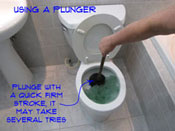 When you use the plunger repeatedly, you may notice the water going down little by little. This is not a bad thing, although it is more satisfying when it goes down in a big whoosh! When the water level gets low enough, you can try flushing the toilet again. You should get the whoosh, this time. If not, try the plunger again.
When you use the plunger repeatedly, you may notice the water going down little by little. This is not a bad thing, although it is more satisfying when it goes down in a big whoosh! When the water level gets low enough, you can try flushing the toilet again. You should get the whoosh, this time. If not, try the plunger again.The plunger does a dirty job and it goes through some less than desirable water. After the clog is cleared flush the toilet two or three more times. Use the fresh water to rinse off the plunger. You can use a toilet brush and some toilet cleaner to further disinfect it.
When toilet clogs are a regular event you may want to keep the plunger close by. Some homeowners have opted to keep it behind the toilet. A nearby closet would be another choice.
It is a good idea to disinfect the rest of the area around the toilet. You likely had some splashing of the dirty water. Some kind of a bleach based cleaning product will kill all the germs and bacteria.
Summary
The 'Introduction' to this series on 'Using a Toilet Plunger' talked about the potential cost you might be facing for fixing your garbage disposal. In addition, the simple solutions and the potential problems were discussed.
In 'Step One', we discussed where to go to purchase a plunger and what kind to get.
'Plunging a Toilet' is the article that told you what to do, what you should get out of the way and how to clean up afterwards.
Were you able to successfully use a toilet plunger to solve your problem? This tool is a champ when it comes to unclogging toilets. Did you have to go out and buy one? It is still cheaper than having a plumber come out. Now that you have it, you will be able to quickly deal with problems in the future.
Now that you are done with this project, what are you going to do next? For a homeowner, there is always a list of repairs that you can tackle. Since this one went so well, you can take a look at your list and try something else.
How To Unblock a Toilet
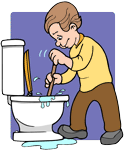 Why would you need to know how to unclog a toilet? Just about every home in the United States has at least one toilet. Many homes have several. From time to time these toilets will clog. When they do it can be a problem. If you are not careful you can get a lot of dirty water all over the floor. What do you do?
Why would you need to know how to unclog a toilet? Just about every home in the United States has at least one toilet. Many homes have several. From time to time these toilets will clog. When they do it can be a problem. If you are not careful you can get a lot of dirty water all over the floor. What do you do?
Not sure if this is your problem? See the articles 'Troubleshooting Toilet Problems' and 'Plumbing Repairs for Homeowners' for a listing of related topics.
New government standards require that toilets use a maximum of 1.6 gallons per flush. That is not a lot of water. Just a few decades ago, toilets used as much as 7 gallons of water per flush. The advantage to this is you save on your water bills. The down side is that not all toilets flush well with that small amount of water.
Do you really need to call a plumber? Usually not. Instead you can learn how to unclog a toilet and solve the problem yourself. Most of the time a plunger can take care of this problem in less than five minutes (clean up, if any, included).
How To Unclog a Toilet - Information
What Can You Save?
A plumber can usually unclog a toilet in a few minutes. You will still have to pay for the service call which will run $50 to $100. Would you take that much for five minutes work?
How Hard Could It Be?
Learning how to unclog a toilet is a fairly simple process.
Check the Simple Things!
Using a plunger is about the simplest thing. A toilet auger is only slightly more difficult.
What Can Go Wrong?
You can wind up with a lot of dirty water on the floor. This can happen if you flush the toilet a second or third time when it is clogged. Plunging a toilet will also generate some splashing. Clear everything out of the area that can be damaged by water. Have some rags handy. You might want to put on some old clothes. Remember, this is dirty water, try to control it.
How to Unclog a Toilet – The Steps Involved
Not much to troubleshoot. The water in the toilet doesn't go down, the toilet is clogged. You need to learn how to unclog a toilet to fix this problem. Usually you never know the reason. Sometimes it is too much volume. Other times something gets caught in the trap.
Before you get started you want to make sure you don't have a more serious drainage problem. Make sure that water is not backing up into another drain, such as the shower or tub, a lower drain. If you have water backing up in multiple drains you have a sewer line problem and not a toilet problem. It may take a professional assessment to determine if the main sewer line is clogged. Check the article 'How to Unclog a Drain', for information on tracking down your problem.
Preparation
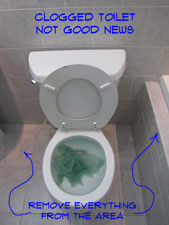 When you learn how to unclog a toilet you want to remember you are dealing with water. Remove everything from the area that could be damaged by dirty water. Some water will probably splash, move anything you don't want ruined.
When you learn how to unclog a toilet you want to remember you are dealing with water. Remove everything from the area that could be damaged by dirty water. Some water will probably splash, move anything you don't want ruined.
Have a mop and rags nearby, just in case. If the water level is up near the rim, you may need to get a small pail and bail some of the water out. A plunger will displace water when it is used. In addition plunging will agitate the water. A high water level will cause splashing and spillover.
Newer toilets do not use much water. You may get away with flushing the toilet a second time. This sometimes can work in your favor, the extra water pressure may force the clog out. The danger is adding more water to a clogged toilet. The higher the water the greater the danger of a spill.
Avoiding toilet clogs makes good sense, especially if you have just got done with cleaning up after one. The old saying goes, 'an ounce of prevention is worth a pound of cure', is apt when it comes to toilets. A toilet that does not get clogged is one less problem in your life.
Do you have a problem with your toilet right now? See the article 'Troubleshooting Toilets' to track down your problem. Want to avoid problems in the future? See the information below.
Make Sure the Toilet is Flushing Properly
Toilets are designed to use a certain amount of water to flush. In the last few decades that amount has been reduced to less than two gallons of water. Toilets have been engineered to work with that amount of water. However, if the amount of water is less than expected, problems will arise.
The first thing you want to do is make sure that you have the proper amount of water in the tank. All toilets have some sort of floatation device that controls the amount of water that is kept in the tank. The water level is controlled by adjusting the float. See the article 'Adjusting the Toilet Tank Water Level' for more information.
The Flapper Needs to Work Correctly
The toilet flapper is part of the toilet flush valve. The flapper is pulled up when you press down on the toilet handle. When it works properly, the flapper closes after the proper amount of water has been released from the tank.
Sometimes the flapper closes too soon and not enough water is released. When this happens the flapper may need to be adjusted or replaced. For a complete discussion on repairing toilet flappers, see the article 'Toilet Flapper Repair'.
Flushing the Toilet Twice
Might sound a little silly, since the toilets are engineered to flush once with a certain amount of water. That is true, but when you have a large volume of material to flush, some extra water can help. Whenever there is a lot of, well, material in the basin and the toilet seems to struggle flushing it, an extra flush can help wash every thing away.
Solids that are not completely washed away can be the beginning of a future clog. This is true of both the toilet itself and the drains that go into the main sewer. Extra water can help to rinse out the toilet and the sewer lines.
Flushing the Right Material
Toilets are designed to deal with human waste. A nasty subject and a dirty job, but toilets are up for the task. However, toilets are not a disposal facility for everything in our homes that we want to get rid of. Certain materials will have a tendency to clog a toilet.
Toilet paper is designed to be flushed down a toilet. The paper breaks down when it is soaked with water and will flow through drains properly. Good practice would dictate that only toilet paper be flushed down the toilet.
Things You Should Not Flush Down the Toilet
It would be impossible to develop a list of things that you should not flush down the toilet. Common sense tells us that there are some common items that we should throw in the trash instead.
The main problem is that, not all paper and non-woven cloths breakdown in a sewer system. Have you ever watched a commercial for a paper towel that absorbs a lot of water, yet does not tear? Well, that paper towel is a good candidate for clogging your toilet or sewer system.
The following is a list of common items that should not be flushed down a toilet:
- Paper Towels
- Disinfectant Wipes
- Sanitary Napkins
- Tampons
- Disposable Diapers
- Cloth or Rags of Any Kind
- Plastic Bags
- Latex Gloves
Items on this list and similar items should be disposed of in another manner. Expensive toilet and sewer problems can result from not following this advice.
Troubleshooting Toilet Clogs
There is no guarantee that toilet clogs can be completely avoided. It does make sense that using some 'best practices' with your toilet will minimize the potential for clogs. If you follow the above suggestions it is likely that clogged toilets will not be a frequent occurrence in your life.
The article 'Troubleshooting Toilet Clogs' helped you to identify your problem and choose the best course of action. You also learned that sometimes the toilet can appear clogged, when you have a more serious sewer problem.
'Removing a Toilet Clog With aPlunger' is the simplest way to eliminate this problem. Plungers will work for the clogged toilets the majority of the time. Most homes have one and it only takes a few minutes.
When something is blocking the toilet, you may need to bring in the heavy artillery. A toilet auger will dislodge items that are caught in the trap. The article 'Using an Auger to Unclog a Toilet' covered the important information.
The article 'Removing a Toilet to Find a Clog' discussed the option of removing the toilet to deal with a clog. This should be viewed as a last ditch effort, when all other options have been tried.
Summary
I am hoping that your ordeal with a toilet clog did not involve removing the toilet. Usually you can solve the problem with a lot less effort. Toilet clogs are a common problem. The plunger is not called the 'plumber's helper' for nothing. Have one handy for future problems.
It is a wonderful feeling when you can make a repair and see such obvious results. When the toilet flushes without incident it means that no one will be bothering you about it. You can sleep at night knowing that no matter when the toilet gets used, it will work.


